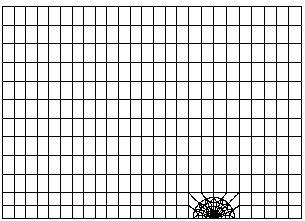3. Modeling A#
3.1. Characteristics of modeling#

Full Template

After symmetrization and orientation

2D initial block

The radius is worth \(\mathrm{7,5E-5}m\)
3.2. Characteristics of the mesh#
The mesh consists of 14888 nodes and 6674 elements, including 1392 QUAD8 elements and 5282 TRIA6 elements.
3.3. Tested sizes and results#
3.3.1. Results achieved with CALC_G#
Identification |
Reference (analytical) |
\(\text{\%}\) tolerance |
G |
1.0019 102 |
2.0 |
KI |
3.5750 106 |
1.0 |
KII |
2.6939 106 |
1.0 |
Table 3.3.1-1
3.3.2. Results achieved with POST_K1_K2_K3#
Identification |
Reference (analytical) |
\(\text{\%}\) tolerance |
G |
1.0019 102 |
4.0 |
KI |
3.5750 106 |
1.2 |
KII |
2.6939 106 |
3.0 |
Table 3.3.2-1
The values obtained with POST_K1_K2_K3 are also tested in non-regression:
Identification |
Reference (non-regression) |
\(\text{\%}\) tolerance |
G |
96.85 |
0.1 |
KI |
3,5379307159775 106 |
0,1 |
KII |
2.6179089643527 106 |
0.1 |
Table 3.3.2-2
We are also testing the possibility of giving POST_K1_K2_K3 the tables movement jumps directly, by doing a test of in relation to the values previously obtained.
Identification |
Reference (other aster) |
\(\text{\%}\) tolerance |
G |
96.85 |
0.1 |
KI |
3,5379307159775 106 |
0,1 |
KII |
2.6179089643527 106 |
0.1 |
Table 3.3.2-3